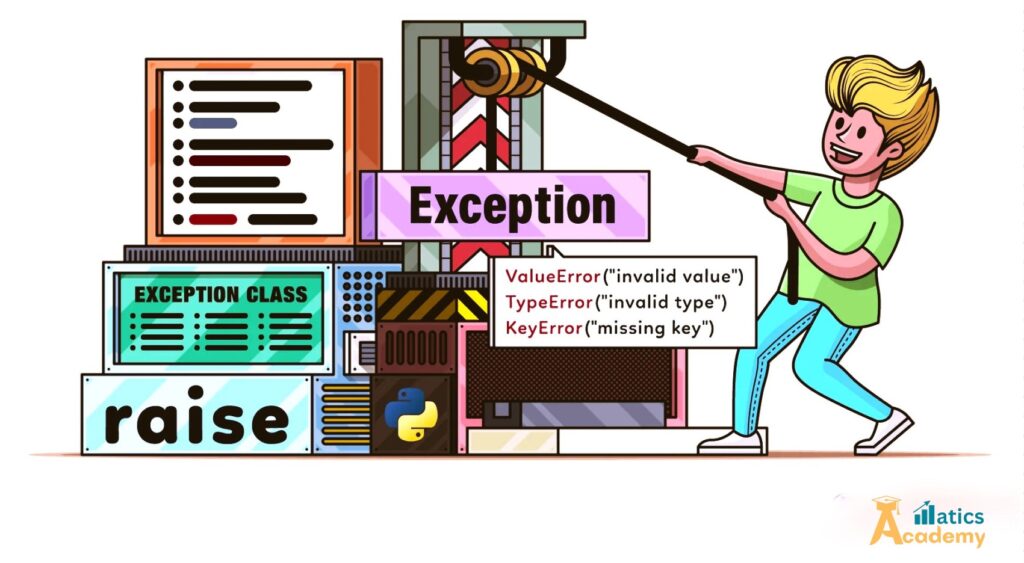Introduction
Exception handling is crucial for writing robust Python programs. Sometimes, an exception arises due to another underlying exception. In such cases, Exception Chaninig allows us to link exceptions, making debugging easier by preserving the root cause of the error. Exception Chaninig is particularly useful in complex applications.

Python achieves this using the raise ... from ... syntax, which explicitly links one exception to another.
Why Use Exception Chaninig?
- Improves Debugging: Helps trace the original cause of an error.
- Preserves Context: Maintains the complete error history.
- Better Error Messages: Gives detailed insights into exceptions.
Exception Chaining Syntax
Python supports Exception Chaninig in two ways:
- Implicit Chaining (Automatically handled by Python)
- Explicit Chaining (Using
raise ... from ...)
1. Implicit Exception Chaninig
When an exception occurs inside an except block, Python automatically chains it using the __cause__ attribute. This implicit Exception Chaninig is helpful in maintaining context.
Example:
try:
x = 1 / 0 # Raises ZeroDivisionError
except ZeroDivisionError as e:
raise ValueError("A higher-level error occurred") # Implicitly linked
Here, Python automatically links the ValueError with ZeroDivisionError.
2. Explicit Exception Chaninig (Using raise ... from ...)
We can explicitly link exceptions using raise new_exception from original_exception. Explicit Exception Chaninig allows for more controlled error handling.
Example:
try:
file = open("non_existent_file.txt", "r") # Raises FileNotFoundError
except FileNotFoundError as e:
raise RuntimeError("Failed to read the required file") from e
Here, the RuntimeError explicitly states that it was caused by FileNotFoundError. This way, Exception Chaining helps in pinpointing the exact source of error.
Accessing Chained Exceptions
Python provides attributes to inspect chained exceptions:
__cause__→ Stores the original exception (used in explicit chaining).__context__→ Stores the previous exception (used in implicit chaining).
Example:
try:
raise ValueError("Main Error") from KeyError("Root Cause")
except ValueError as e:
print(f"Error: Cause: {e.__cause__}") Best Practices for Exception Chaining
- Use
raise ... from ...for meaningful error messages. - Provide informative messages to help debugging.
- Use exception chaining sparingly, only when necessary.
Conclusion
Exception Chaining is a powerful debugging tool that helps track the root cause of errors in Python. Using raise ... from ..., developers can create clear, informative error messages that simplify troubleshooting. By following best practices for Exception Chaining, we can make Python applications more robust and maintainable.
Additional Topics:
Interview Questions:
1. What is Exception Chaining in Python?(TCS)
Answer:
Exception Chaining is a mechanism that links an exception to another using raise ... from .... It helps trace the original cause of an error and improves debugging.
2. What is the difference between implicit and explicit exception chaining?(Infosys)
Answer:
Implicit chaining occurs when an exception is raised inside an except block, automatically linking errors. Explicit chaining uses raise new_exception from old_exception, manually linking exceptions.
3. How can we access the original exception in a chained exception?(Google)
Answer:
We can use the __cause__ attribute for explicit chaining and __context__ for implicit chaining. This highlights the versatility and usefulness of Exception Chaining in Python development.
Remember What You Learn!
Question
Your answer:
Correct answer:
Your Answers
